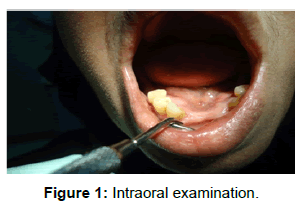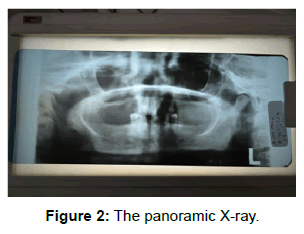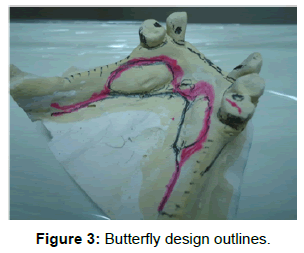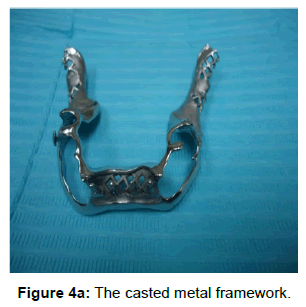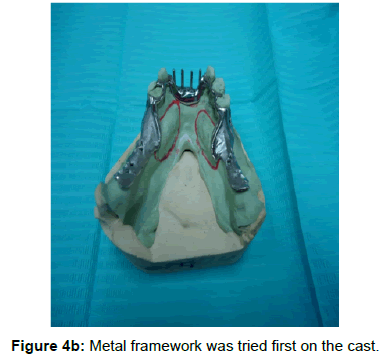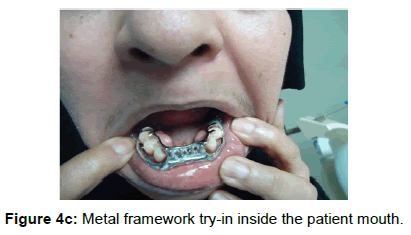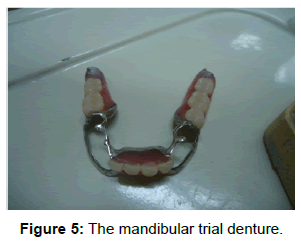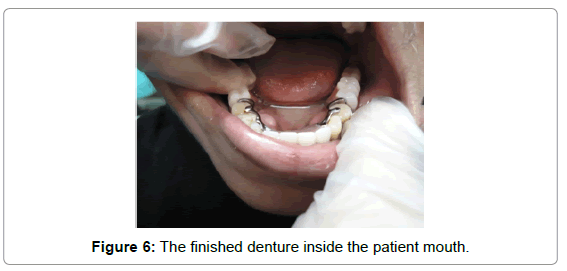Case Report Open Access
A Suggested Butterfly Design for Mandibular Tori in Partially Edentulous Patient: Clinical Case Report
Ezzat AKH1*, Tayel SB1 and Al-Khiary YM2
1Associate Professor of Prosthodontics, Faculty of Dentistry, King Abdul-Aziz University, Kingdom of Saudia Arabia
2Professor of Prosthodontics, Faculty of Dentistry, King Abdul Aziz University, Kingdom of Saudia Arabia
- *Corresponding Author:
- Ezzat AKH
Faculty of Dentistry
King Abdul-Aziz University
Kingdom of Saudia Arabia
Tel: 2226322263
E-mail: abdelsalamezzat@yahoo.com
Received Date: September 06, 2013; Accepted Date: November 12, 2013; Published Date: November 16, 2013
Citation: Ezzat AKH, Tayel SB, Al-Khiary YM (2013) A Suggested Butterfly Design for Mandibular Tori in Partially Edentulous Patient: Clinical Case Report. J Oral Hyg Health 1:116. doi: 10.4172/2332-0702.1000116
Copyright: © 2013 Ezzat AKH, et al. This is an open-access article distributed under the terms of the Creative Commons Attribution License, which permits unrestricted use, distribution, and reproduction in any medium, provided the original author and source are credited.
Visit for more related articles at Journal of Oral Hygiene & Health
Abstract
Oral tori if present can cause noticeable discomfort not only for the patient but also for the treating dentist. Some tori can be overcome by relief if simple while others have to be removed surgically. Sometimes a dentist may face case (s) of maxillary or mandibular torus at medically compromised patient (s) where surgery is contraindicated. This suggested design shaped as butterfly was suggested in such a case to help a medically compromised female patient suffering from big sized bilateral torus mandibularis is to wear removable prosthesis without making surgery to remove it. The weakness of the design as it lacks to any lingual major connector overcome by thick strong labial bar. The design was found to be satisfying for the patient standard requirements.
Keywords
Oral tori; Torus mandibularis; Maxillary torus; Butterfly design
Introduction
Tori are non-pathological nodular protuberance of mature bone whose precise occurrence destination depends on anatomical location [1]. Tori can be easily diagnosed and no biopsy is necessary, its Surgical removal is not required unless in case of chronic trauma or interference that interfere with oral functions or with the replacement of a denture base or framework [2].
Tori are asymptomatic and exhibit slow growth during the second and the third decade of life [3]. Racial differences appear significant, with higher prevalence in Asians and Eskimos [4,5]. Torus palatinus is found more frequent in women [6,7] whereas torus mandibularis affects more men [8]. Etiology of tori has been investigated and several factors have been proposed including genetic factor [9-11] environmental factors [10,11], masticatory hyper function [12] and continued growth [13]. Recent study showed positive association between the presence of torus mandibularis and bone mineral density [14].
Case Report
A (76) years old female patient came to the prosthodontics outpatient clinic at Faculty of Dentistry, King Abdul-Aziz University complaining of being edentulous for a long period of time and seeking for a solution for her problem.
Medical and dental histories revealed that she is diabetic with congested heart failure due to chronic hypertension more than 15 years back. She visited many dental clinics and all her treating dentists told her that she needs surgery to remove bilateral mandibular tori to replace her teeth. Intraoral examination revealed presence of maxillary class 1 kennedy`s partially edentulous arch opposed with mandibular class I modification (1) kennedy`s classification. Remaining mandibular teeth No (33, 34 43, 44 and 45) and some calculus deposits detected in the anterior lingual mandibular segment (Figure 1).
Decayed tooth No. 33 which needs class (v) composite filling.
Bilateral big sized mandibular tori covered with thin layer of mucosa were detected lingually on both sides of the premolar regions of (12 mm length, 4 mm height and extends to occupy the full depth of the lingual sulci) and making the construction of conventional removable partial denture (RPD) impossible as the lingual bar or plate of the framework will interfere and traumatize the whole lingual sulci.
Panoramic radiograph was used to detect any oral pathology (Figure 2).
Treatment planning
• Scaling and root planning for the remaining teeth were done as their periodontal health condition is good and they can share in bearing an (RPD) as revealed by the panoramic x-ray. Polishing of the teeth for proper shade guide selection and oral hygiene regime was prescribed at home in the form of mouth wash, tooth paste and a soft tooth brush.
• Class (V) composite filling for the decayed tooth No (33) was done.
• Referral for her physician to describe a suitable tranquilizer to calm her down and to assure her that no surgery will be done.
Prosthodontics procedures
• The planned treatment was placement of definitive maxillary class 1 denture and mandibular class1 modification (1) Kennedy`s classification cobalt chromium based RPDS.
• Maxillary and mandibular alginate impressions in stock trays were made to get the study casts. Tripod marks were used to record the position of the mandibular cast, teeth No 34 & 45 were selected as the main abutments and the favorable path of insertion and removal was selected.
• After primary surveying, the design was drawn. It was in the form of a butterfly framework away from sites of mandibular tori with bilateral saddle areas extended at the most distal parts of lingual sulci, labial bar as major connector, gingival approaching clasps on abutment teeth No. 34 & 45, cingulum rests on teeth No. 33, 34 and mesially placed occlusal rests on teeth No. 34 & 45 (Figure 3).
• The necessary abutments preparations were done inside the patient mouth.
• Acrylic special trays were border molded using modeling plastic impression compound and final impressions were taken with polyvinyl siloxane impression material. Impressions were poured in hard dental stone.
• On the mandibular master cast after final surveying the unnecessary undercuts were obliterated, the saddle areas and the labial section is relieved to accept a labial bar as a major connector, ledges were prepared for the selected clasps and the duplicate (working cast) is obtained. The drawing design on the work authorization sheet with color coding was sent to the laboratory for construction of the metallic framework.
• The metallic framework was tried in the patient mouth and the necessary adjustments done until the framework fitted well and the patient was satisfied (Figures 4a-4c).
• An altered cast impression technique was made using zinc oxide and euginol impression paste to record the functional form of the saddle areas. It was sent to the laboratory to make maxillary and mandibular record blocks.
• Jaw relation records & face bow transfer were recorded and the shade guide was selected. The casts were mounted in semiadjustable articulator for final teeth arrangement. The occlusion was designed following the concept of lingualized occlusion.
• After trial insertion, the denture was sent to the laboratory for processing (Figure 5).
• The upper and lower finished dentures were inserted and the necessary occlusal adjustment was made. The patient expressed her comfort. She was able to She was able to insert and remove the prosthesis easily. Esthetics were good and she was able to was able to pronounce and reads some phrases properly (Figure 6).
• The patient was instructed for oral hygiene measures, how to use and maintain her dentures at home and a follow up was scheduled after 24 hours if she feels pain and after 48 hours is given for any further necessary occlusal adjustment or to relieve any complaint.
Discussion
The butterfly design was constructed with no lingual major connector, only the saddles extend to the most distal part of the ligual sulci forming a butterfly shape. As mandibular toti are covered by an extremely thin layer of soft tissue they may be easily irritated and interfere painfully by slight movement of the denture base in the mouth during the insertion and removal of the mandibular RPD that explains why they are left uncovered by the design.
This weakness of the design was substituted with a strong labial bar to reinforce the design.
Gingival approaching clasps retained the prosthesis in place offering stress breaking action on the abutments raising their durability and their life time together with the prosthesis.
The indirect retention is mainly afforded by the cingulum rests and the occlusal rest prepared on the canines and on teeth No 43 and 44.
The butterfly design satisfied the patient’s requirements; avoiding her any surgery .The possible complications of surgery includes lingual nerve damage in cases of distally extended tori, infection and floor of mouth hemorrhage. The latter is a rare sequel but can be life threatening and must be managed immediately in order to prevent airway embarrassment impairment [13].
Lingualized occlusion concept was applied during setting of the cusped artificial teeth to create balanced occlusion avoiding any premature contacts between maxillary and mandibular teeth during the excursive movements. Feather touch between the maxillary and mandibular anterior teeth was performed to avoid any trauma to the underlying maxillary anterior alveolar ridge to avoid Kelly`s syndrome. The missing anterior maxillary teeth were set in proper vertical and horizontal relations to the mandibular anterior teeth for maximal esthetic and phonetic considerations. Several trials were made till the patient was able to pronounce some letters as (s,th,f and z) properly and she was esthetically satisfied.
Conclusion
The Proposed butterfly design may be beneficial in bilateral big sized mandibular tori and similar cases with medically compromised patients. The design is comfortable to the patient, fits easily and is esthetically accepted.
References
- Regezi JA, Sciuba JJ (1994) Oral pathology, clinico-pathologic correlations (3rdedn). Wb saunders, Philadelphia, pp: 367-378.
- Jainkittivong A, Apinhasmit W, Swasdison S (2007) Prevalence and clinical characteristics of oral tori in 1,520 Chulalongkorn University Dental School patients. Surg Radiol Anat 29: 125-131.
- Gorsky M, Bukai A, Shohat M (1998) Genetic influence on the prevalence of torus palatinus. Am J Med Genet 75: 138-140.
- Chew CL, Tan PH (1984) Torus palatinus. A clinical study. Aust Dent J 29: 245-248.
- Yaacob H, Tirmzi H, Ismail K (1983) The prevalence of oral tori in Malaysians. J Oral Med 38: 40-42.
- Bouquot JE, Gundlach KK (1986) Oral exophytic lesions in 23,616 white Americans over 35 years of age. Oral Surg Oral Med Oral Pathol 62: 284-291.
- Eggen S, Natvig B (1994) Concurrence of torus mandibularis and torus palatinus. Scand J Dent Res 102: 60-63.
- Haugen LK (1992) Palatine and mandibular tori. A morphologic study in the current Norwegian population. Acta Odontol Scand 50: 65-77.
- Gould AW (1964) An Investigation of the Inheritance of Torus Palatinus and Torus Mandibularis. J Dent Res 43: 159-167.
- Axelsson G, Hedegård B (1981) Torus mandibularis among Icelanders. Am J Phys Anthropol 54: 383-389.
- Axelsson G, Hedegaard B (1985) Torus palatinus in Icelandic schoolchildren. Am J Phys Anthropol 67: 105-112.
- Eggen S, Natvig B (1986) Relationship between torus mandibularis and number of present teeth. Scand J Dent Res 94: 233-240.
- Ellertson CH (1969) Continuous growth of the torus mandibularis. Oral Surg Oral Med Oral Pathol 27: 786-789.
- Hjertstedt J, Burns EA, Fleming R, Raff H, Rudman I, et al. (2001) Mandibular and palatal tori, bone mineral density, and salivary cortisol in community-dwelling elderly men and women. J Gerontol A Biol Sci Med Sci 56: M731-735.
Relevant Topics
- Advanced Bleeding Gums
- Advanced Receeding Gums
- Bleeding Gums
- Coronal Fracture
- Dental Anestheia and Sedation
- Dental Plaque
- Dental Radiology
- Dentistry and Diabetes
- Gum Cancer
- Gum Infection
- Occlusal Splint
- Oral Hygiene Blogs
- Oral Hygiene Case Reports
- Oral Hygiene Practice
- Oral Leukoplakia
- Oral Surgery Special Issue
- Orthodontistry
- Periodontistry
- Root Canal Treatment
Recommended Journals
Article Tools
Article Usage
- Total views: 27573
- [From(publication date):
December-2013 - May 26, 2024] - Breakdown by view type
- HTML page views : 22630
- PDF downloads : 4943

